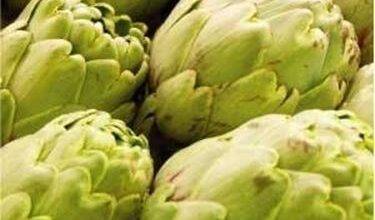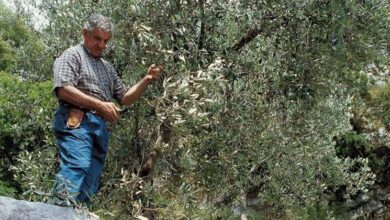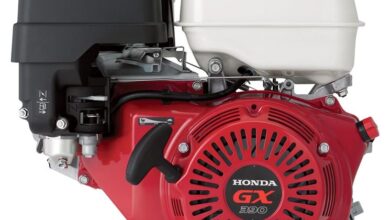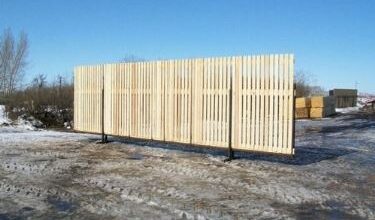Babaco – Carica pentagona
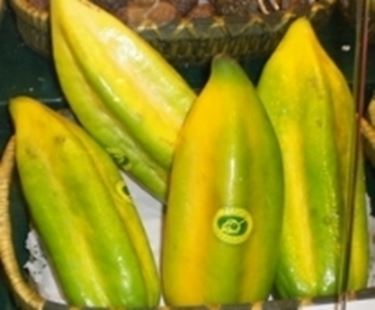
Generality
It is a herbaceous and shrubby plant, characterized by rapid development, after one year from planting it can be 3 m high. The roots are fleshy and tuberous and colonize the first 30-40 cm of soil after six months of cultivation, later they deepen becoming larger. The stem is spongy, fibrous, greyish and has a decreasing diameter from the base to the apex. The leaves are concentrated in the upper part, alternate, palmate, have 5-7 lobes and a pointed apex; the leaf has a rather considerable size, it can be 50 cm long and 45 cm wide, with a 55 cm long petiole. The flowers are only female, campanulaceous, greenish-white, solitary or gathered in groups of 2-3 and inserted at the axil of the leaves. In Italy, flowering occurs throughout the summer so it is very scaly,

Fruits
The fruit is a seedless berry, 30 cm long and 10 wide, with a pointed rounded apex and a pentagonal section. The skin is dark green on the not yet ripe berries, with yellow streaks on the partially ripe ones, while it is completely yellow on fully ripe fruits. When ripe, the pulp is creamy white, watery, fragrant and has an intermediate flavor between pineapple and orange. The fruits reach their maximum size two months before harvest.
A berry has an average weight of 1 kg, but on the same plant there can be others that weigh 2 kg; each plant bears more or less 35-40 fruits. Babaco plants, obtained from multiplication by cuttings or by micropropagation, are very uniform in different crops, so there are currently no distinguishable cultivars.
Climate and terrain
The babaco prefers humid and rainy climates, with temperatures between 6 and 30 ° C, those close to zero cause serious damage to the plant. Strong winds can defoliate the plant, therefore, if grown in open field in windy areas, it is necessary to resort to windbreak barriers. The ideal exposure is in full sun, if the brightness is too intense it can cause the leaves to curl, so in summer you can proceed with the shading of the greenhouse (in Italy).
The babaco grows well on sandy, medium-textured, deep, volcanic and sandy clay soils, on clayey-silty soils drainage and bedding are essential as water stagnations cause rotting of the roots and collar. It is native to the highlands of Ecuador, Australia and New Zealand; in Italy it is grown in greenhouses especially in Lazio, in this case it is important to avoid drafts that lower the temperature and relative humidity, favoring the onset of physiological disorders in plants.
Cultivation techniques
In our country, wooden or galvanized iron greenhouses are used, covered with neutral polyethylene, equipped with hot air or water heating systems; they must have a minimum height of 3.5 m at the highest point. Before planting, a 50-60 cm hole must be made with a fertilization based on mature manure integrated with phospho-potassium fertilizers. The seedlings are planted in spring in a 30-40 cm wide and deep circular hole, then burying it with soil enriched with peat and fertilizer. The planting layouts adopted are 1.5 X 1.5 m as the adult leaves of the babaco can reach a length of one meter, petiole included. On the row it is better to mulch with black polyethylene film in order to control the development of weeds, soil parasites and rationalize irrigation water. During the growth phase the plants must be kept at a height not exceeding 2 m avoiding the formation of new apical flowers; after 2-3 production cycles the plant is topped at 30 cm from the ground with the execution of an oblique cut to favor the development of the lateral shoot which will give life to a new cycle.
Fertilization consists in administering phosphorus and potassium in February and fractionating the nitrogen during the whole vegetative cycle of the babaco, distributing it in low dosages and away from the stem as it has a caustic action; fertilizers can be added through fertigation. In the babaco cultivation areas where the rainfall is less than 50 mm per month, it is necessary to intervene with emergency irrigation. In very hot regions, sprinkler or nebulization irrigation systems are chosen which increase the relative humidity of the air by limiting excessive heat, in areas that are not too hot it is preferable to adopt the drip system. The harvest is gradual and can last for 6-12 months, the optimal time corresponds to a dark green color with yellow streaks on the fruits.

